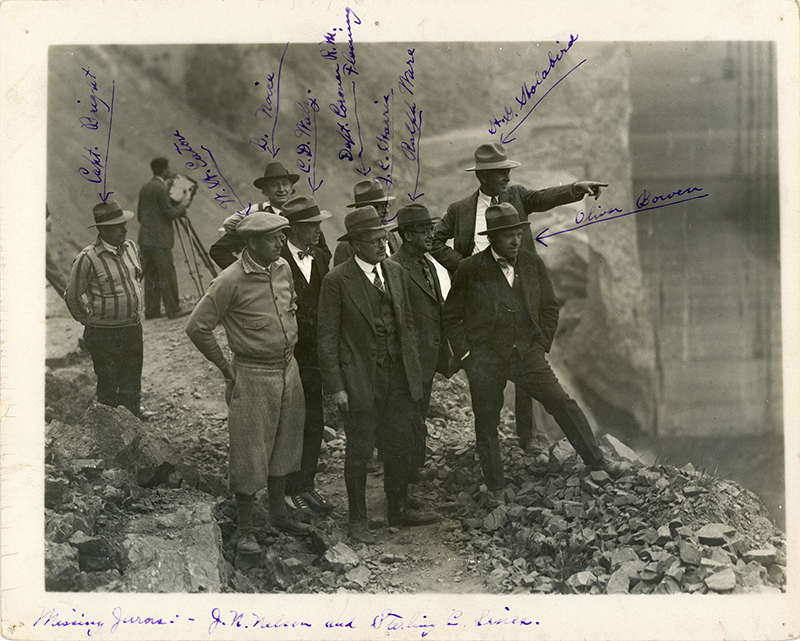|
|

Verdict of Coroner's Jury.
St. Francis Dam Disaster.
Los Angeles, April 12, 1928.
|
Who or what was responsible for the death of 29-year-old Julia Rising — and by extension the rest of the people whose bodies filled morgues from Saugus to the sea after the St. Francis Dam collapsed? That was the question for the jury empaneled by Los Angeles County Coroner Frank A. Nance on March 19, 1928, a week after the fatal flood. The coroner's inquest began March 21 and continued until final testimony was taken April 10. The verdict was rendered two days later.
Abstract. We, the Jurors summoned to appear before the Coroner of Los Angeles County at the Coroner's Office, Hall of Justice, Los Angeles, California, on the 21st day of March, A.D., 1928, to inquire into the cause of the death of Julia Rising, et al, having been duly sworn according to law, and having made such inquisition and hearing the testimony adduced, upon our oaths, each and all do say that we find that the deceased was named Julia Rising, (et al) a female, married, a native of Minnesota, aged about 29 years, and that she came to her death on the 13th day of March, 1928, by drowning and other injuries, caused by the failure and destruction of the St. Francis Dam, and we find that her death was accidental. Conclusions. After carefully weighing all of the evidence, that has been presented, we have reached the following conclusions: 1st. The St. Francis Dam was defective due to the very poor quality of the underlying rock structure upon which it was built and to the fact that the design of the dam was not suited to inferior foundation conditions. The actual failure was caused either wholly or in part by these defects. 2nd. The construction of this dam, without having the design and foundation conditions passed upon by independent engineers and geologists, and without more thorough and systematic methods of design, supervision and inspection, involved two basic errors. One of these was an error in engineering judgment in determining the character of the foundations at the St. Francis Dam site and deciding upon the best type of darn to build there. The other was an error in regard to fundamental policy relating to public safety. The responsibility for the error in engineering judgment rests upon the Bureau of Water Works and Supply and the Chief Engineer thereof. The responsibility for the error in public policy belongs to those to whom the Chief Engineer is subservient, including the Department of Water and Power Commissioners, the legislative bodies of city and state, and to the public at large. It is a logical result of a set of conditions that the citizenship has allowed to develop and continue. This is the more fundamental error, for if proper safeguards had been provided in the city charter and in the state laws, making it impossible for excessive responsibility to be delegated to or assumed by any one individual in matters involving great menaces to public safety, it is unlikely that the engineering error would have escaped detection and produced a great disaster. A sound policy of public safety and business and engineering judgment demands that the construction and operation of a great dam should never be left to the sole judgment of one man, no matter how eminent, without check by independent expert authority, for no one is free from error, and checking by independent experts will eliminate the effect of human error and insure safety. The exemption of municipalities from supervision by state authorities in the building of dams involving public hazards is a very serious defect of the state law that should be corrected. [...] We, the Jury, find no evidence of criminal act or intent on the part of the Board of Water Works and Supply of the City of Los Angeles, or any engineer or employee in the construction or operation of the St. Francis Dam, and we recommend that there be no criminal prosecution of any of the above by the District Attorney.
Download pdf here. Courtesy of Ann Stansell.
|
SEE ALSO:
Transcript of Coroner's Inquest
Hall of Justice 1928
Verdict of Coroner's Jury
Arizona Report 1928
Popular Science 1964
• Rippens Story of Dam Disaster (1998)
Vital Lesson for Today (ASDSO 2018)
At Dam Site 3-14-1928
With Van Norman at Dam Site 3-15-1928
Coroner's Jury Inspects 3/1928
Hall of Justice 1928
Fountain 1940s
Aqueduct Memorial Garden Opens at Mulholland Fountain: Story 10-23-2013
Mulholland Fountain & Aqueduct Garden: Photo Gallery 11-10-2013
|
The site owner makes no assertions as to ownership of any original copyrights to digitized images. However, these images are intended for Personal or Research use only. Any other kind of use, including but not limited to commercial or scholarly publication in any medium or format, public exhibition, or use online or in a web site, may be subject to additional restrictions including but not limited to the copyrights held by parties other than the site owner. USERS ARE SOLELY RESPONSIBLE for determining the existence of such rights and for obtaining any permissions and/or paying associated fees necessary for the proposed use.
















